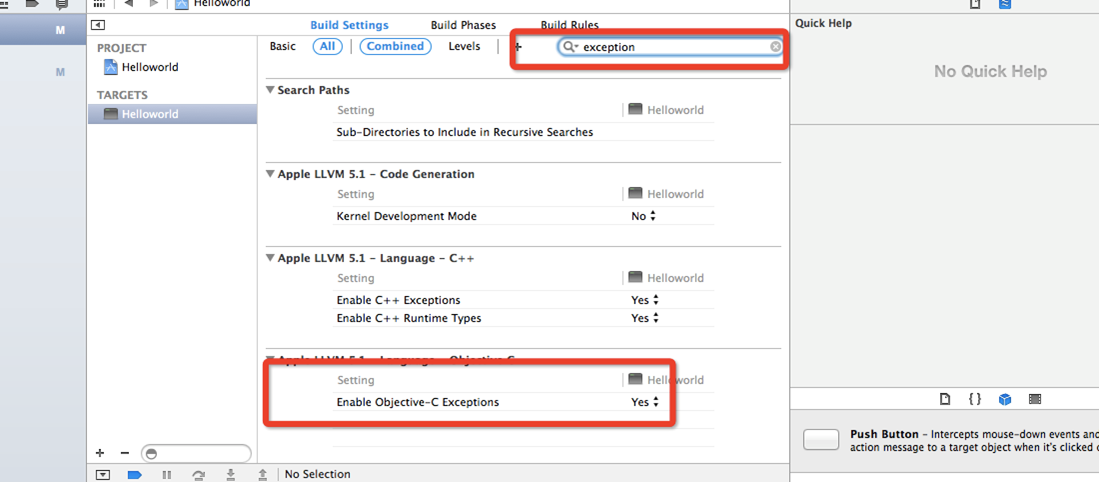Objective-C Memory Management Being Exceptional 异常处理与内存
Objective-C Memory Management Being Exceptional 异常处理与内存
3.1Cocoa requires that all exceptions must be of type NSException
cocoa 需要所有的异常是NSException类型的。
so even though you can throw an exception from other objects, Cocoa isn't set up to deal with those.
所以你即使从别的类抛出异常,cocoa 也不会处理。
Exception handling is really intended for errors that are generated by your programs. Cocoa frameworks usually handle errors by exiting the program, which is not what you want. You should throw and catch exceptions in your code, instead of letting them escape to the framework level.
cocoa框架通常用已经存在的程序解决异常。你应该throw and catch exceptions 在你自己的代码中,而不是任其跑到框架层。
To enable support for exceptions, make sure the -fobj-exceptions flag is turned on.
为了支持异常,你应该确保-fobj-exceptions打开。

When an exception is thrown and is not caught, the program stops at the exception point and propagates the exception.
当一个异常抛出后,并没有被接到的话,则程序停在异常点。
3.2 Keywords for exceptions
All the keywords for exceptions start with @. Here's what each one does
所以的异常keyword 均以@开头。
(1)@try: Defines a block of code that will be tested to determine if an exception
should be thrown.
测试一个异常是否应该被抛出。
(2)@catch(): Defines a block of code for handling a thrown exception. Takes an
argument, typically of type NSException, but can be of other types.
处理异常
(3)@finally: Defines a block of code that gets executed whether an exception is
thrown or not. This code will always be executed.
不管是否抛出异常都运行。
(4)@throw: Throws an exception.
抛出异常
3.3 Catching Different types of exceptions
You can have multiple @catch blocks depending on which type of exception you want to handle.
可以根据exception 的类型来选择@catch 的类型
@try{
} @catch (MyCustomException *custom) {
} @catch (NSException *exception) {
} @catch (id value) {
} @finally {
}
A program throws an exception by creating an instance of NSException and using one of two techniques:
一个程序抛出异常通过创建NSException 和使用下面的技术:
(1)Using @throw exception;
(2)Sending a raise message to an NSException objectwe'll create an exception: 我们建一个NSExcepiton
NSException *theException = [NSException exceptionWithName: ...];
We can then throw with either 我们throw 通过下面:
@throw theException;
or
[theException raise];
You'll usually throw exceptions from inside the exception handling code.
也可以在一个exception handling code里再抛出异常。
@try {
NSException *e = ...;
@throw e; }
@catch (NSException *e) {
@throw; // rethrows e.
}
2.4 Exceptions need memory management too . 异常也需要内存管理
Memory management can be tricky when exceptions are involved.
- (void)mySimpleMethod
{
NSDictionary *dictionary = [[NSDictionary alloc] initWith....];
[self processDictionary:dictionary];
[dictionary release];
}
let's imagine that processDictionary throws an exception. The program jumps out of this method and looks for an exception handler. But because the method exits at this point, the dictionary object is not released, and we have a memory leak.
假如processDictionary 抛出异常,但是dictionary 还没有释放,因此有了memory leaks .
解决办法:One simple way to handle this is to use @try and @finally, doing some cleanup in @finally because it's always executed (as we said earlier).
在@finally 处处理,因为总是执行。
- (void)mySimpleMethod
{
NSDictionary *dictionary = [[NSDictionary alloc] initWith....];
@try {
[self processDictionary:dictionary];
}
@finally {
[dictionary release];
}
}
2.5 Exceptions and autorelease pools 异常和自动释放池
Exceptions are almost always created as autoreleased objects because you don't know when they will need to be released. When the autorelease pool is destroyed, all objects in that pool are destroyed also, including the exception.
Exceptions 几乎总是被创作为自动释放因为你不知道什么时候结束。
- (void)myMethod
{
NSAutoreleasePool *pool = [[NSAutoreleasePool alloc] init];
NSDictionary *myDictionary =
[[NSDictionary alloc] initWithObjectsAndKeys:@"asdfads", nil];
@try {
[self processDictionary:myDictionary];
} @catch (NSException *e) {
@throw;
} @finally {
[pool release];
}
}
There's a problem when we think about exception handling. We discussed earlier that we can rethrow exceptions in the @catch block, which causes the @finally block to execute before the exception is rethrown.
我们可以rethrow exceptions 在@catch block中。这导致了@finally在异常抛出前执行。
This will cause the local pool to be released before the exception can be delivered, thus turning it into a dreaded zombie exception.
这将导致恐怖的zombie exception.
- (void)myMethod
{
id savedException = nil;
NSAutoreleasePool *pool = [[NSAutoreleasePool alloc] init];
NSDictionary *myDictionary =
[[NSDictionary alloc] initWithObjectsAndKeys:@"asdfads", nil];
@try {
[self processDictionary:myDictionary];
} @catch (NSException *e) {
savedException = [e retain];
@throw;
} @finally {
[pool release];
[savedException autorelease];
}
}
By using retain, we saved the exception in the parent pool. When our pool is released, we already have a pointer saved, and when the parent pool is released, the exception will be released with it.
通过retain ,我们保留了这个exception 在parent pool。
Objective-C Memory Management Being Exceptional 异常处理与内存的更多相关文章
- Objective -C Memory Management 内存管理 第一部分
Objective -C Memory Management 内存管理 第一部分 Memory management is part of a more general problem in pr ...
- [译]C# 7系列,Part 10: Span<T> and universal memory management Span<T>和统一内存管理
原文:https://blogs.msdn.microsoft.com/mazhou/2018/03/25/c-7-series-part-10-spant-and-universal-memory- ...
- Memory Management in Open Cascade
Open Cascade中的内存管理 Memory Management in Open Cascade eryar@163.com 一.C++中的内存管理 Memory Management in ...
- Java (JVM) Memory Model – Memory Management in Java
原文地址:http://www.journaldev.com/2856/java-jvm-memory-model-memory-management-in-java Understanding JV ...
- Objective-C Memory Management
Objective-C Memory Management Using Reference Counting 每一个从NSObject派生的对象都继承了对应的内存管理的行为.这些类的内部存在一个称为r ...
- Operating System Memory Management、Page Fault Exception、Cache Replacement Strategy Learning、LRU Algorithm
目录 . 引言 . 页表 . 结构化内存管理 . 物理内存的管理 . SLAB分配器 . 处理器高速缓存和TLB控制 . 内存管理的概念 . 内存覆盖与内存交换 . 内存连续分配管理方式 . 内存非连 ...
- Android内存管理(2)HUNTING YOUR LEAKS: MEMORY MANAGEMENT IN ANDROID PART 2
from: http://www.raizlabs.com/dev/2014/04/hunting-your-leaks-memory-management-in-android-part-2-of- ...
- Android内存管理(1)WRANGLING DALVIK: MEMORY MANAGEMENT IN ANDROID PART 1
from : http://www.raizlabs.com/dev/2014/03/wrangling-dalvik-memory-management-in-android-part-1-of-2 ...
- Understanding Memory Management(2)
Understanding Memory Management Memory management is the process of allocating new objects and remov ...
随机推荐
- RabbitMQ常用命令、管理界面
1.运行CMD,cd切换到RabbitMQ安装目录sbin下E:\Program Files\RabbitMQ Server\rabbitmq_server-3.7.2\sbin 执行 rabbitm ...
- C项目实践--贪吃蛇(1)
1.功能需求分析 1.1主要功能 i.游戏欢迎界面 ii.游戏执行功能,包括计算得分 iii.游戏结束界面 1.2游戏基本规则 游戏开始时蛇的长度是4个单位,并且按照当前方向不停地移动.移动范围是CO ...
- maximize_window fullscreen_window minimize_window
# Licensed to the Software Freedom Conservancy (SFC) under one# or more contributor license agreemen ...
- css中vertical-align和line-height的用法
css中vertical-align和line-height的用法 1.先来看一种现象: (1).将一个图片放入一个div块中,div块背景颜色设置为aquamarine.将会发现图片与div块下边沿 ...
- SoapUI中Code多行显示设置
你们的SoapUI 有设置下面的选项吗? Before adding your project, we recommend that you enable the following ReadyAPI ...
- tcp与socket关系
套接字(socket)是通信的基石,是支持TCP/IP协议的网络通信的基本操作单元.
- eclipse自动创建项目出错Cannot change version of project facet Dynamic Web Module to 2.3.
Cannot change version of project facet Dynamic Web Module to 2.3. step1:修改properties step2:修改web.xml ...
- 数据库sqlite3的使用-基本语法
一.SQL语句 如果要在程序运行过程中操作数据库中的数据,那得先学会使用SQL语句 1.什么是SQL SQL(structured query language):结构化查询语言 SQL是一种对关系型 ...
- 并不对劲的bzoj3626:loj2558:p4211:[LNOI2014]LCA
题目大意 有一棵有\(n\)(\(n\leq5*10^4\))个点的树,\(q\)(\(q\leq5*10^4\))次询问,每次给出\(l,r,x\)表示询问所有编号在\([l,r]\)的点与点\(x ...
- ML.NET
ML.NET http://www.cnblogs.com/BeanHsiang/category/1218714.html 随笔分类 - 使用ML.NET实现NBA得分预测 摘要: 本文将介绍一种特 ...
